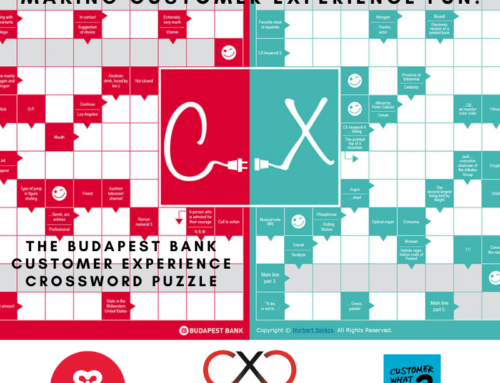
We are all customers. We buy products and services. We buy brands.
When it comes to our own organizations, however, we disconnect our consumer self with our business self. “Out in the wild” we know that our customer experience is shaped by the perception we have in each interaction with a brand. In other words, we keep buying the brands that give us the positive experience we remember – one that stands out from all the others. It might be a good product or even a great price, but the thing that will always keep us coming back over and over is the experience. So why don’t we prioritize this for our business, for our customers?
Let me give you an example. I love Chinese food; my wife and kids love Chinese food. When I call my preferred Chinese restaurant to order our Friday night takeaway, they know who I am and what I’m likely going to order – without introducing myself. Of course, they got my name from the Caller ID registered in their system, but this is a classic example of what we call Basic Personalization, and it works. Based on my history and preferences, they also know when I come to collect my order not to add in the free prawn crackers (as we’re a vegetarian household). This is omnichannel customer experience to a tee, and we’re all experiencing it every day in the places we are most likely to do business with again tomorrow.
While collecting Friday night takeaway is not necessarily the most bleeding-edge example of an omnichannel customer journey, it is one that can operate easily. With its somewhat limited, localised customer base, the restaurant can rely on the human element of remembering customer preferences and providing a personal touch to their service be it on the phone or in person. It’s this type of experience customers are expecting from all brands, at every touchpoint, regardless of what they are buying (e.g., cars, software, apparel). Now, how do businesses with a much larger, more diverse customer base have this personal touch online, offline and at scale?
What CX is: It’s Listening
When I was in the Conversion Rate Optimisation (CRO) business, we had a client whose poorly designed customer experience was the way it was, because the marketing director KNEW this was the best approach: with no user acceptance testing and no AB testing of different navigations, design or contents against conversion rates. The digital marketing team came to us on another pretext and wanted to side-load CRO into a broader project plan to try and get the marketing director to see the error of his ways, by using data to disprove his hypotheses. One of the first tests was a simple change to a banner, which led to an uplift in online sales of two percent against sales driven from the version of the banner mandated by the marketing director. The customers had essentially spoken about which experience they preferred, and the marketing director was presented with data that he listened to.
According to Walker, by 2020, customer experience will stand out as the key brand differentiator, even over price. Further, in Forrester Research Inc.’s, “Digital Business 2018: Benchmark for Digital Journey” report, industry analyst Nigel Fenwick found that customer obsession pushes companies toward digital maturity, which is a stepping stone to digital transformation that can help organisations, according to Forrester, increase customer lifetime value (CLV) and enter new markets. When companies optimise for experience, conversions follow, and for longer – something AB testing each website element alone cannot account for.
Where to Begin: Customer Insights
Brands need to know their customer, which isn’t the same as knowing customers as aggregated statistics in a popular analytics system but rather knowing each customer by their name, their age, their job and contact details as well as which type of products they have purchased, and what else they may like that is relevant to what a company offers. My favourite Chinese restaurant’s employees don’t need to know I work at Episerver, but they do need to know that I like takeaway on Friday nights after work and am picking up food for my family. If it’s my anniversary, however, we could have other dinner plans and may skip our usual Friday night order.
Details like this start to paint a picture of intent and next actions. Online, it’s about knowing what content customers looked at before they made a purchase and what content they immediately clicked away from or didn’t engage with.
How about if you send them an email, do you know when they are most likely to open it?
When marketers have this in place, they can start to understand the value of each customer to their brand over time (i.e., the almighty CLV). Organisations can look at building personas of their key customer groups and enhance the experience for the higher value customers. B2B companies, for example, can build up their ideal client profile (ICP) and consider how they can tailor the experience for those types of business customers.
What to do Next: Optimize the Journey
Companies thinking about the user journey as a series of interactions on different channels need to stop.
Siloing the channels in this way is dangerous for the customer experience as marketers stop taking that holistic view of the complete journey of an individual in all its different contexts, and instead start to fragment the way the organisation thinks about it (i.e., by employee role or company department). Rather, the customer journey is a single entity that needs to be nurtured.
Once brands connect the dots between customer interactions on different touchpoints, employees and the technologies that support them can start mapping out where customers have been and where they may be going. Show the customer what they want to see, in a way that they can relate to, on any screen or device, at a time that is relevant to them.
Don’t start throwing ‘Buy’ buttons or other CTAs straight in their face (even if they are tested for colour or placement), but guide and nurture the journey, build up a mutual trust and rapport before going for the bite.
Marketers can begin by defining journey maps for preferred personas by:
- Looking to see where the customer experience may be lacking for certain segments and try to optimize at each touchpoint.
- Making use of AB or multi-variant testing (MVT) of content, banners, page designs and navigations for different segments and see which convert best.
- Avoid looking at just the big picture (i.e., bottom line conversions such as purchases, bookings or confirmation page loads), but rather look at each stage of the conversion funnel and see if small changes, say a product page, encourage people to add to basket, make an enquiry or take a next step.
- Creating inspirational content that relates to a company’s ideal client will help them find the brand, establish an emotional attachment and feel more comfortable about doing business with them versus a faceless organisation.
- Partnering with like-minded companies or networks that the consumer may find him or herself visiting throughout their journey.
Hold the Prawns
To really differentiate and stand out from the crowd, organisations need to bring each individual that interacts with their brand, a killer customer experience at every touchpoint. By perceiving the channels and stages not as separate entities, but as a single journey that can be optimized at each touchpoint and stand out to the customer, the customer will feel like the company loves them back. Everything from promotions to products should be delivered in a way that proves whether, figuratively, the company knows if the customer wants the prawn crackers or not.
About the Author
With extensive experience in the digital and technology industries, Greg Moore has a solid background in Digital Analytics, Conversion Rate Optimisation, Personalisation and Campaign Automation, qualifying him as an evangelist for Episerver products.
My book, ‘Customer What? – the honest and practical guide to customer experience’ – is now available to purchase! You can do so on Amazon.com or Amazon.co.uk. If Amazon does not ship to your part of the world, please complete the form found here and I will arrange an alternative method to ship a book to you. Enjoy the read!!







Leave A Comment